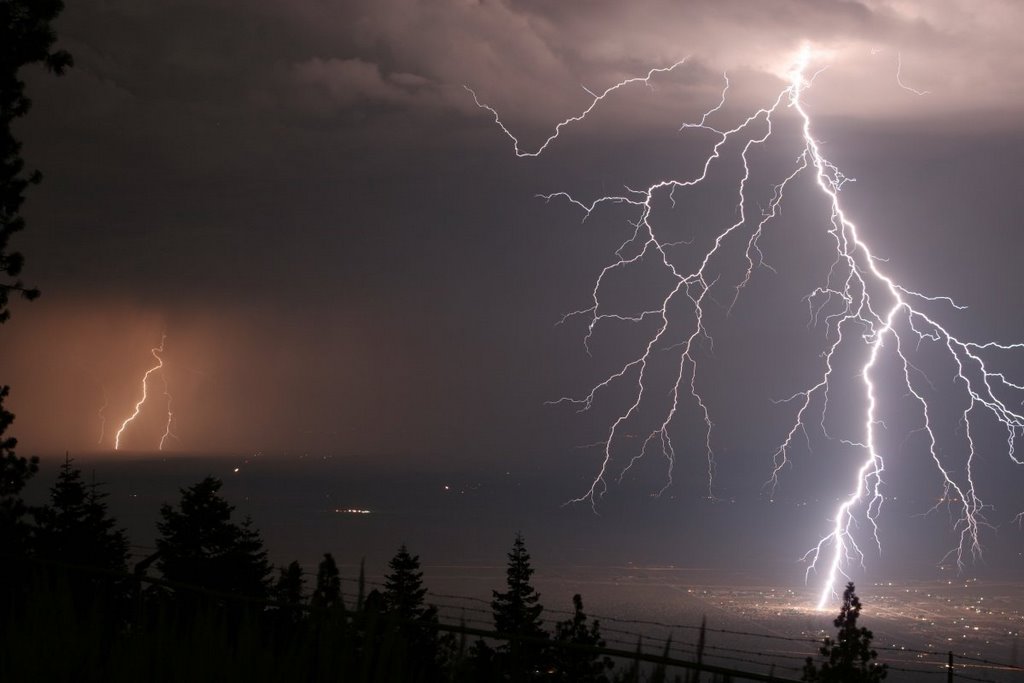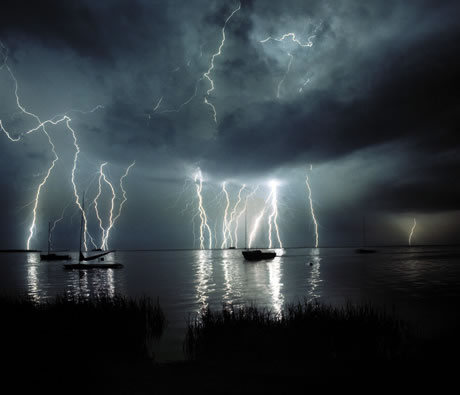Random Facts About... Lightning
Lightning is a wonderful and breath-taking phenomenon to witness. At the same time it's one of the most dangerous and unpredictable demonstrations of power ever seen in nature. But how much do you really know about them? Below you'll find out some curious facts, known and unknown.
1. At this very moment there are about 1800 thunderstorms in the atmosphere.
2. Lightning bolts travel at speeds of up to 60,000 miles per second.
3. The temperature of a typical lightning bolt can reach 50,000 F degrees – that is 5 times greater than the temperature of the surface of the Sun.
4. The energy contained in a single lightning strike can power a 100 Watt light bulb for 90 days.
5. Ancient Greeks believed that when a lightning strike hit the sea a new pearl appeared.
6. The average length of a single lightning bolt is 2-3 miles.
7. You can hear thunder from about 12 miles from the starting point.
8. An average instance of lightning lasts about a quarter of a second and consists of 3-4 strikes.
9. “Lightning never strikes twice” unfortunately is a myth. Lightning can strike the same location many times.
10. Trees sometimes can take direct hits from lightning and not get burnt – the electricity passes over their wet surface and goes straight into the ground.
11. Every year, the Earth experiences an average of 25 million lightning strikes during some 100,000 thunderstorms. That’s more than a hundred lightning bolts per second.
12. The Aztecs believed that lightning accompanied the dead, splitting the earth and making its way into its depths.
13. The irrational fear of lightning is known as keraunophobia. The fear of thunder is termed brontophobia.
14. In the Middle Ages it was believed that church bells expelled evil spirits. Thunder and lightning were regarded as diabolical, so during a thunderstorm monks tried to constantly ring the bells. As a result the victims of lightning very often were bell-ringers.
15. If you have wet clothes on, lightning will do you less harm.
16. Glass forms when lightning strikes into sandy soil. After a storm you can find strips of glass in the sand.
17. Lightning hits the Empire State Building in New York about 23 times a year.
 18. Lightning strikes also occur on Venus, Jupiter, Saturn, and Uranus.
18. Lightning strikes also occur on Venus, Jupiter, Saturn, and Uranus.
19. There are from 100 to 1000 instances of ball lightning at the same time on Earth, but the chance you’ll see at least one in your lifetime is just 0.01%.
20. In March of 1991 a single six-hour storm stretching over Iowa, Illinois, Wisconsin, and Missouri caused more than 15,000 lightning strikes. During the storm the skies were ablaze with almost constant lightning.
21. A single lightning bolt travels through twisted paths in the air that can be as wide as one of your fingers or between six and ten miles.
22. About 71% of all people struck by lightning survive. The fatal cases are usually the result of cardiac arrest. However, those who survive often suffer from serious health and psychological problems like loss of memory or sensitivity, insomnia, impaired hearing, or constant pain.
23. The chance to be killed by lightning is 1 in 2,000.000. You have the same chance dying from falling out of bed.
 24. On average, about 200 people are killed by lightning in the United States every year.
24. On average, about 200 people are killed by lightning in the United States every year.
25. Never talk on the phone while a storm is breaking outside. Not only do cell phones “attract” lightning, but about 1% of all lightning deaths in the U.S. are a result of people talking inside the home on a corded phone during a thunderstorm.
26. The state of Florida holds the title of the “Deadliest State.” There are twice as many lightning casualties as in any other state. 10% of all people struck by lightning were in Florida at the time.
These are all scientific curiosities that make lightning bolts so dangerous. Or maybe is just nature trying to tell us something. Just guessing...
1. At this very moment there are about 1800 thunderstorms in the atmosphere.
2. Lightning bolts travel at speeds of up to 60,000 miles per second.
3. The temperature of a typical lightning bolt can reach 50,000 F degrees – that is 5 times greater than the temperature of the surface of the Sun.
4. The energy contained in a single lightning strike can power a 100 Watt light bulb for 90 days.
5. Ancient Greeks believed that when a lightning strike hit the sea a new pearl appeared.
6. The average length of a single lightning bolt is 2-3 miles.
7. You can hear thunder from about 12 miles from the starting point.
8. An average instance of lightning lasts about a quarter of a second and consists of 3-4 strikes.
9. “Lightning never strikes twice” unfortunately is a myth. Lightning can strike the same location many times.
10. Trees sometimes can take direct hits from lightning and not get burnt – the electricity passes over their wet surface and goes straight into the ground.
11. Every year, the Earth experiences an average of 25 million lightning strikes during some 100,000 thunderstorms. That’s more than a hundred lightning bolts per second.
12. The Aztecs believed that lightning accompanied the dead, splitting the earth and making its way into its depths.
13. The irrational fear of lightning is known as keraunophobia. The fear of thunder is termed brontophobia.
14. In the Middle Ages it was believed that church bells expelled evil spirits. Thunder and lightning were regarded as diabolical, so during a thunderstorm monks tried to constantly ring the bells. As a result the victims of lightning very often were bell-ringers.
15. If you have wet clothes on, lightning will do you less harm.
16. Glass forms when lightning strikes into sandy soil. After a storm you can find strips of glass in the sand.
17. Lightning hits the Empire State Building in New York about 23 times a year.
 18. Lightning strikes also occur on Venus, Jupiter, Saturn, and Uranus.
18. Lightning strikes also occur on Venus, Jupiter, Saturn, and Uranus.19. There are from 100 to 1000 instances of ball lightning at the same time on Earth, but the chance you’ll see at least one in your lifetime is just 0.01%.
20. In March of 1991 a single six-hour storm stretching over Iowa, Illinois, Wisconsin, and Missouri caused more than 15,000 lightning strikes. During the storm the skies were ablaze with almost constant lightning.
21. A single lightning bolt travels through twisted paths in the air that can be as wide as one of your fingers or between six and ten miles.
22. About 71% of all people struck by lightning survive. The fatal cases are usually the result of cardiac arrest. However, those who survive often suffer from serious health and psychological problems like loss of memory or sensitivity, insomnia, impaired hearing, or constant pain.
23. The chance to be killed by lightning is 1 in 2,000.000. You have the same chance dying from falling out of bed.
 24. On average, about 200 people are killed by lightning in the United States every year.
24. On average, about 200 people are killed by lightning in the United States every year.25. Never talk on the phone while a storm is breaking outside. Not only do cell phones “attract” lightning, but about 1% of all lightning deaths in the U.S. are a result of people talking inside the home on a corded phone during a thunderstorm.
26. The state of Florida holds the title of the “Deadliest State.” There are twice as many lightning casualties as in any other state. 10% of all people struck by lightning were in Florida at the time.
These are all scientific curiosities that make lightning bolts so dangerous. Or maybe is just nature trying to tell us something. Just guessing...





Comments
Post a Comment